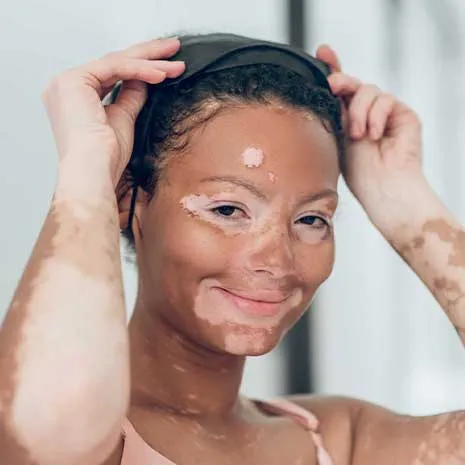Common Body Areas Affected by Vitiligo

Common Body Areas Affected by Vitiligo
- 18 July 2025
- 187

Vitiligo is an autoimmune skin condition characterized by the loss of melanocytes, the pigment-producing cells of the skin. This results in the appearance of white patches in various areas of the body. While vitiligo can occur anywhere on the skin or mucous membranes, some regions are more commonly affected than others due to factors such as sun exposure, friction, trauma, and melanocyte distribution.
In this article, we explore the most frequent anatomical locations where vitiligo manifests, the clinical significance of each area, their response to treatment, and the challenges patients face depending on the site of involvement.
Segmental vs. Non-Segmental Vitiligo: How Distribution Varies
Vitiligo presents in two main clinical forms:
- Non-segmental vitiligo (NSV): The most common type, symmetrical and often progressive.
- Segmental vitiligo (SV): Usually unilateral, localized, and occurs at an earlier age.
|
Vitiligo Type |
Commonly Affected Areas |
Notes |
|
Non-segmental |
Face, hands, feet, elbows, knees, genitals, eyes, neck |
Bilateral and symmetrical distribution |
|
Segmental |
Trunk, limbs, face (unilateral) |
Confined to one dermatome, early onset |
1. Face and Perioral Region
The face is one of the most frequently affected areas, especially around the mouth, eyes, nose, and forehead. Since it is always visible, facial involvement can significantly impact a patient’s self-esteem.
Key points:
- Often the first site of involvement in many patients
- Includes the periorbital and perioral regions
- Sun-exposed, making depigmentation more pronounced
- Responds well to topical therapy and narrowband UVB
2. Hands and Feet
The backs of the hands, fingers, wrists, toes, and ankles are among the most common and most treatment-resistant sites of vitiligo.
Why are these areas so affected?
- Frequent mechanical trauma (friction, injury)
- Lower blood supply reduces regenerative capacity
- Melanocyte reservoir may be limited in acral skin
Treatment response:
Generally poor. These areas often show minimal repigmentation even with phototherapy. Targeted treatments like excimer laser may offer better results.
3. Elbows and Knees
Elbows and knees are common pressure points and therefore susceptible to vitiligo due to Koebner phenomenon—where skin trauma induces lesion formation.
Key characteristics:
- Often affected in children and young adults
- Symmetrical distribution is common
- Depigmented patches may become more visible due to movement and pressure
Treatment approach:
Moderate response. Combination of topical corticosteroids or calcineurin inhibitors with NB-UVB is often used.
4. Genital Area and Skin Folds
The genital and intertriginous regions (e.g., armpits, groin) are sensitive areas that are frequently affected but often underreported due to embarrassment or social stigma.
Why it matters:
- May affect sexual confidence and relationships
- Can be misdiagnosed as fungal or inflammatory conditions
- Thin skin requires low-potency, non-steroidal treatments like tacrolimus
Note: Genital vitiligo can cause significant psychological burden despite being medically benign.
5. Scalp and Hair-Bearing Areas
Vitiligo in the scalp may result in poliosis—the whitening of hair in patches due to loss of melanocytes in hair follicles. This includes:
- Scalp
- Eyebrows
- Eyelashes
- Beard (in men)
Clinical signs:
- White or gray hair in well-defined areas
- Usually painless
- More of a cosmetic concern, especially in young individuals
6. Eyelids and Around the Eyes
Eyelids and the periorbital area are commonly affected due to thin skin and exposure to environmental factors.
Treatment precautions:
- Use only low-potency corticosteroids or calcineurin inhibitors
- Avoid overuse due to risk of skin thinning
- Excimer laser can be effective for localized lesions
7. Trunk (Chest, Abdomen, Back)
Although less visible, the trunk is often involved in widespread cases of non-segmental vitiligo.
Characteristics:
- May appear later in the disease progression
- Often symmetrical, especially on the abdomen and back
- Affected areas may remain stable or slowly progress
Treatment response:
Moderate to good. Phototherapy is generally effective in this region, especially when initiated early.
Koebner Phenomenon and Lesion Localization
The Koebner phenomenon is a well-known mechanism in vitiligo, where new lesions appear at sites of skin trauma, including:
- Cuts, abrasions, and burns
- Areas with tight clothing or repetitive friction
- Regions that undergo frequent shaving or scratching
Understanding this helps explain why vitiligo commonly affects high-friction and exposed areas and reinforces the importance of skin protection.
Frequently Asked Questions
Common starting points include the face, hands, and areas around the eyes and mouth.
These areas have low blood flow and are subject to constant friction, which impedes repigmentation.
Yes. Genital involvement is common but often underreported due to stigma. It is not contagious or dangerous but may affect self-image.
No. Vitiligo may cause whitening of the hair (poliosis) but does not cause hair to fall out.
Yes. Due to the Koebner phenomenon, repeated trauma can trigger new lesions in vulnerable areas.
